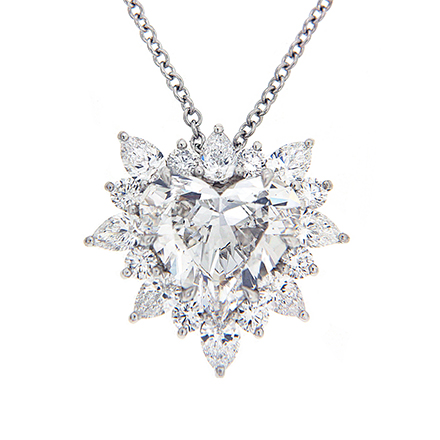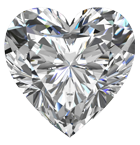 Of all the four Cs of diamond quality, cut is the most complex to grade. This is in part due to the wide range of diamond cuts, and the subjective nature of aesthetics. People may have differing ideas as to what makes a cut beautiful, which in turn can make a verifiable cut grade tricky. Some cuts, such as the round brilliant, have consistent standards which make grading simpler while others have a large range of variable.
Of all the four Cs of diamond quality, cut is the most complex to grade. This is in part due to the wide range of diamond cuts, and the subjective nature of aesthetics. People may have differing ideas as to what makes a cut beautiful, which in turn can make a verifiable cut grade tricky. Some cuts, such as the round brilliant, have consistent standards which make grading simpler while others have a large range of variable.
The Gemological Institute of America, or GIA, created the 4Cs of diamond quality in the 1950s. GIA has continued to research and innovate, finding ways to improve upon its assessment of diamond cuts. Developments included a fifteen-year study of thousands of diamonds, examining how light travels through the stone and the way different aspects of cut influences a jewel’s appearance.
When light enters a diamond, it slows and changes the angle at which it travels. A well-cut brilliant diamond should have light enter its uppermost facet and travel a complex path through the interior of the gem before exiting the way it came. The number of facets, their angles and the stone’s overall proportions influence light’s path. Other considerations include the balance of white and colored light, as well as shadows.
GIA evaluates diamond cut in laboratories with controlled lighting for optimal accuracy. The Institute has developed equipment that rotates the stone, analyzing its measurements and light performance. From there, software produces a larger image of the diamond to allow graders to better examine the jewel. Docks which use neutral, diffuse and spot lighting further help graders assess different aspects of a diamond’s light performance.
Diamond cut is evaluated by how its face up appearance, its design, and the skill in fashioning the jewel. Brilliance, fire and scintillation are aspects of light which should emerge from the face of the diamond. The first term refers to the way white light brightens the interior of a diamond, the second to colored light in the jewel, and the third is the play of light and dark within a diamond. Design factors include a stone’s durability and weight ratio. Craftsmanship qualities include a jewel’s symmetry and the quality of its polish.
Evaluating diamond cut is a complicated process. First is to find standards within a type of diamond cut to make grading as objective and verifiable as possible. Continuing research to improve upon these guidelines adds to better understanding of cut. Specialized equipment and carefully monitored lighting further aids evaluations.
Heart Diamonds
Hearts are symbolically represented as two round lobes balanced on top of a point. The image has long been used as a sign of love, especially romantic. Diamonds are also used to represent sentimental feelings. The two are often combined in the form of heart shaped fancy cut diamonds.
Cutting diamonds is tricky no matter the shape, and hearts are particularly complicated. Good symmetry and polish are essential. Their tips should be pointed, and the jewel’s length to with ratio should be 1:1. Brilliance is also important. If there is a bow tie shadow within the gem, it should be minimized.
 Heart diamonds should be curved just so. The lobes, which form the upper half of the shape, should be neither too flat nor elongated, and have defined cleft, or gap, in between them. Wings are the portion of the diamond which leads to the tip. These too should be rounded, though in a subtler fashion than the lobes.
Heart diamonds should be curved just so. The lobes, which form the upper half of the shape, should be neither too flat nor elongated, and have defined cleft, or gap, in between them. Wings are the portion of the diamond which leads to the tip. These too should be rounded, though in a subtler fashion than the lobes.
The point of a heart shaped diamond is prone to damage. To protect your jewel, it’s best to get a setting that protects the point such as a V shaped prong or a bezel setting. Those who prefer large amounts of brilliance in their diamonds may prefer a half bezel or prong mounts, which allow more light to travel through the stone.
Heart shaped diamonds are a complex brilliant fancy cut. There are many details to keep in mind when searching for the right diamond for yourself. However, between their brilliance and their strong association with love, heart shaped diamonds are a popular choice for diamond engagement rings and other jewelry.
Diamond Points
While most diamonds purchased today are round, other shapes such as squares, marquises and hearts are also popular. Many of these shapes have acute or right angles ending in sharp corners known as points. The crystal structure of diamonds means that jewels with points require special consideration.
While diamonds are very hard, they’re not indestructible. At their thinnest portions, such as girdles and points, diamonds are vulnerable to chipping. Common solutions include faceting girdles rather than giving them knife edges, and cropping the corners of square or rectangular cuts. The latter is commonly seen in emerald cuts, which were specially designed for fragile gems.
Ways to protect diamond points from harm, other than cropping, usually involve the mount. Prongs which encase points, such as the V-shape, protect against accidental damage. Bezel mounts, which use a strip of precious metal around the girdle to hold the jewel in place, provide a greater level of protection. To ensure the security of your diamond, check the tightness of the setting from time to time.
When selecting a diamond with points, look for ones with defined tips. Those with blunter ends tend to be less aesthetically pleasing. It’s also important that points be in balance with the rest of the shape, being neither too short nor elongated. For square or rectangular jewels, their corners should be at right angles to highlight their gem’s shapes.





